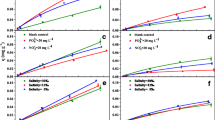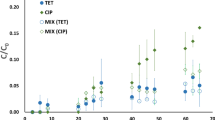Abstract
It is important to study the fate and transport of antibiotics in aquatic environments to reveal their pollution status. The premise behind fate and transport studies is to evaluate the reaction processes of the target antibiotics. However, available research on the environmental behaviors of antibiotics in certain natural waters, such as estuarine water, is scarce. In this study, single reactions such as sorption, biodegradation, and photolysis and multiple degradation reactions of sulfamethoxazole (SMX), trimethoprim (TMP), and ciprofloxacin (CIP) in the estuarine water were studied. The sorption rates of the target antibiotics in the estuarine water-sediment system were very fast, and the sorption amounts varied among sediments and antibiotics. Hydrolysis did not contribute to the degradation of the target antibiotics. Biodegradation had a low contribution to the degradation of the target antibiotics in the estuarine water. In comparison, photolysis was the dominant degradation process for SMX, TMP, and CIP. The rates of photolysis of the tested antibiotics in the estuarine water were greater than those in pure water; thereby, indicating photolysis of these antibiotics was more prone to occur in the estuarine water. In the multiple degradation experiments, it was found that there may be synergistic effects between the single degradation processes. Thus, the aqueous concentrations of antibiotics decreased rapidly by sorption after entering the estuarine water and then decreased relatively slowly by photolysis and biodegradation. This study provides information for evaluating the environmental behaviors of antibiotics in estuarine environments.






Similar content being viewed by others
References
Adamek E, Baran W, Sobczak A (2016) Assessment of the biodegradability of selected sulfa drugs in two polluted rivers in Poland: effects of seasonal variations, accidental contamination, turbidity and salinity. J Hazard Mater 313:147–158
Alexy R, Kumpel T, Kummerer K (2004) Assessment of degradation of 18 antibiotics in the closed bottle test. Chemosphere 57:505–512
Alharbi SK, Kang J, Nghiem LD, van de Merwe JP, Leusch FDL, Price WE (2017) Photolysis and UV/H2O2 of diclofenac, sulfamethoxazole, carbamazepine, and trimethoprim: identification of their major degradation products by ESI-LC-MS and assessment of the toxicity of reaction mixtures. Process Saf Environ 112:222–234
Amorim CL, Moreira IS, Maia AS, Tiritan ME, Castro PML (2014) Biodegradation of ofloxacin, norfloxacin, and ciprofloxacin as single and mixed substrates by Labrys portucalensis F11. Appl Microbiol Biotechnol 98:3181–3190
Arlos MJ, Bragg LM, Servos MR, Parker WJ (2014) Simulation of the fate of selected pharmaceuticals and personal care products in a highly impacted reach of a Canadian watershed. Sci Total Environ 485:193–204
Bialk-Bielinska A, Stolte S, Arning J, Uebers U, Boschen A, Stepnowski P, Matzke M (2011) Ecotoxicity evaluation of selected sulfonamides. Chemosphere 85:928–933
Bialk-Bielinska A, Stolte S, Matzke M, Fabianska A, Maszkowska J, Kolodziejska M, Liberek B, Stepnowski P, Kumirska J (2012) Hydrolysis of sulphonamides in aqueous solutions. J Hazard Mater 221:264–274
Biel-Maeso M, Baena-Nogueras RM, Corada-Fernandez C, Lara-Martin PA (2018) Occurrence, distribution and environmental risk of pharmaceutically active compounds (PhACs) in coastal and ocean waters from the Gulf of Cadiz (SW Spain). Sci Total Environ 612:649–659
Biosic M, Mitrevski M, Babic S (2017) Environmental behavior of sulfadiazine, sulfamethazine, and their metabolites. Environ Sci Pollut Res 24:9802–9812
Cao X, Pang H, Yang G (2015) Sorption behaviour of norfloxacin on marine sediments. J Soils Sediments 15:1635–1643
Caracciolo AB, Grenni P, Rauseo J, Ademollo N, Cardoni M, Rolando L, Patrolecco L (2018) Degradation of a fluoroquinolone antibiotic in an urbanized stretch of the River Tiber. Microchem J 136:43–48
Cardoza LA, Knapp CW, Larive CK, Belden JB, Lydy M, Graham DW (2005) Factors affecting the fate of ciprofloxacin in aquatic field systems. Water Air Soil Pollut 164:383–398
Carstens KL, Gross AD, Moorman TB, Coats JR (2013) Sorption and photodegradation processes govern distribution and fate of sulfamethazine in freshwater-sediment microcosms. Environ Sci Technol 47:10877–10883
Chapman PM, Wang FY (2001) Assessing sediment contamination in estuaries. Environ Toxicol Chem 20:3–22
Charuaud L, Jarde E, Jaffrezic A, Thomas MF, Le Bot B (2019) Veterinary pharmaceutical residues from natural water to tap water: sales, occurrence and fate. J Hazard Mater 361:169–186
Cheng J, Jiang L, Sun T, Tang Y, Du Z, Lee L, Zhao Q (2019) Occurrence, seasonal variation and risk assessment of antibiotics in the surface water of North China. Arch Environ ConTox 77:88–97
Choi YJ, Kim LH, Zoh KD (2016) Removal characteristics and mechanism of antibiotics using constructed wetlands. Ecol Eng 91:85–92
Fernandez-Calvino D, Bermudez-Couso A, Arias-Estevez M, Novoa-Munoz JC, Fernandez-Sanjurjo MJ, Alvarez-Rodriguez E, Nunez-Delgado A (2015) Kinetics of tetracycline, oxytetracycline, and chlortetracycline adsorption and desorption on two acid soils. Environ Sci Pollut Res 22:425–433
Garcia-Galan MJ, Diaz-Cruz MS, Barcelo D (2012) Kinetic studies and characterization of photolytic products of sulfamethazine, sulfapyridine and their acetylated metabolites in water under simulated solar irradiation. Water Res 46:711–722
Gmurek M, Horn H, Majewsky M (2015) Phototransformation of sulfamethoxazole under simulated sunlight: transformation products and their antibacterial activity toward Vibrio fischeri. Sci Total Environ 538:58–63
Gobel A, McArdell CS, Suter MJ, Giger W (2004) Trace determination of macrolide and sulfonamide antimicrobials, a human sulfonamide metabolite, and trimethoprim in wastewater using liquid chromatography coupled to electrospray tandem mass spectrometry. Anal Chem 76:4756–4764
Guerra P, Kim M, Shah A, Alaee M, Smyth SA (2014) Occurrence and fate of antibiotic, analgesic/anti-inflammatory, and antifungal compounds in five wastewater treatment processes. Sci Total Environ 473:235–243
Homem V, Santos L (2011) Degradation and removal methods of antibiotics from aqueous matrices - a review. J Environ Manag 92:2304–2347
Hosseini NA, Parker WJ, Matott LS (2012) Modelling concentrations of pharmaceuticals and personal care products in a Canadian watershed. Can Water Resour J 37:191–208
Huijbers PMC, Larsson DGJ, Flach CF (2020) Surveillance of antibiotic resistant Escherichia coli in human populations through urban wastewater in ten European countries. Environ Pollut 261:114200
Ingerslev F, Halling-Sorensen B (2000) Biodegradability properties of sulfonamides in activated sludge. Environ Toxicol Chem 19:2467–2473
Jia Y, Khanal SK, Shu H, Zhang H, Chen GH, Lu H (2018) Ciprofloxacin degradation in anaerobic sulfate-reducing bacteria (SRB) sludge system: mechanism and pathways. Water Res 136:64–74
Kummerer K (2010) Pharmaceuticals in the environment. Annu Rev Environ Resour 35:57–75
Li J, Cui M, Zhang H (2020) Spatial and temporal variations of antibiotics in a tidal river. Environ Monit Assess 192(336):336
Li J, Zhang H (2016) Adsorption-desorption of oxytetracycline on marine sediments: kinetics and influencing factors. Chemosphere 164:156–163
Li J, Zhang H (2017) Factors influencing adsorption and desorption of trimethoprim on marine sediments: mechanisms and kinetics. Environ Sci Pollut Res 24:21929–21937
Li J, Zhang KN, Zhang H (2018) Adsorption of antibiotics on microplastics. Environ Pollut 237:460–467
Li WH, Shi YL, Gao LH, Liu JM, Cai YQ (2012) Occurrence of antibiotics in water, sediments, aquatic plants, and animals from Baiyangdian Lake in North China. Chemosphere 89:1307–1315
Lin AYC, Reinhard M (2005) Photodegradation of common environmental pharmaceuticals and estrogens in river water. Environ Toxicol Chem 24:1303–1309
Lin JS, Pan HY, Liu SM, Lai HT (2010) Effects of light and microbial activity on the degradation of two fluoroquinolone antibiotics in pond water and sediment. J Environ Sci Health B 45:456–465
Liu SS, Zhao HX, Lehmler HJ, Cai X, Chen J (2017) Antibiotic pollution in marine food webs in Laizhou Bay, North China: trophodynamics and human exposure implication. Environ Sci Technol 51:2392–2400
Loftin KA, Adams CD, Meyer MT, Surampalli R (2008) Effects of ionic strength, temperature, and pH on degradation of selected antibiotics. J Environ Qual 37:378–386
Luo Y, Mao DQ, Rysz M, Zhou QX, Zhang HJ, Xu L, Alvarez PJJ (2010) Trends in antibiotic resistance genes occurrence in the Haihe River, China. Environ Sci Technol 44:7220–7225
Ngigi AN, Magu MM, Muendo BM (2020) Occurrence of antibiotics residues in hospital wastewater, wastewater treatment plant, and in surface water in Nairobi County, Kenya. Environ Monit Assess 192(1)
Norvill ZN, Shilton A, Guieysse B (2016) Emerging contaminant degradation and removal in algal wastewater treatment ponds: identifying the research gaps. J Hazard Mater 313:291–309
Patrolecco L, Rauseo J, Ademollo N, Grenni P, Cardoni M, Levantesi C, Luprano ML, Caracciolo AB (2018) Persistence of the antibiotic sulfamethoxazole in river water alone or in the co-presence of ciprofloxacin. Sci Total Environ 640:1438–1446
Riaz L, Mahmood T, Khalid A, Rashid A, Siddique MBA, Kamal A, Coyne MS (2018) Fluoroquinolones (FQs) in the environment: a review on their abundance, sorption and toxicity in soil. Chemosphere 191:704–720
Schowanek D, Webb S (2002) Exposure simulation for pharmaceuticals in European surface waters with GREAT-ER. Toxicol Lett 131:39–50
Simpson JH, Vennell R, Souza AJ (2001) The salt fluxes in a tidally-energetic estuary. Estuar Coast Shelf S 52:131–142
Tong L, Eichhorn P, Perez S, Wang Y, Barcelo D (2011) Photodegradation of azithromycin in various aqueous systems under simulated and natural solar radiation: kinetics and identification of photoproducts. Chemosphere 83:340–348
Van Boeckel TP, Brower C, Gilbert M, Grenfell BT, Levin SA, Robinson TP, Teillant A, Laxminarayan R (2015) Global trends in antimicrobial use in food animals. P Natl Acad Sci USA 112:5649–5654
Wang L, Yang L, Li Y, Zhang Y, Ma X, Ye Z (2010) Study on adsorption mechanism of Pb(II) and Cu(II) in aqueous solution using PS-EDTA resin. Chem Eng J 163:364–372
Xu B, Mao D, Luo Y, Xu L (2011) Sulfamethoxazole biodegradation and biotransformation in the water-sediment system of a natural river. Bioresour Technol 102:7069–7076
Zhang C, Hu XF, Luo YM (2016) Aqueous photodegradation of oxytetracycline under simulated sunlight irradiation. Huan**g Huaxue-Environ Chem 35:430–438
Zhang RJ, Tang JH, Li J, Zheng Q, Liu D, Chen YJ, Zou YD, Chen XX, Luo CL, Zhang G (2013) Antibiotics in the offshore waters of the Bohai Sea and the Yellow Sea in China: occurrence, distribution and ecological risks. Environ Pollut 174:71–77
Zhu YG, Johnson TA, Su JQ, Qiao M, Guo GX, Stedtfeld RD, Hashsham SA, Tiedje JM (2013) Diverse and abundant antibiotic resistance genes in Chinese swine farms. P Natl Acad Sci USA 110:3435–3440
Zhuang J, Wang S, Tan Y, **ao R, Chen J, Wang X, Jiang L, Wang Z (2019) Degradation of sulfadimethoxine by permanganate in aquatic environment: influence factors, intermediate products and theoretical study. Sci Total Environ 671:705–713
Funding
This study was financially supported by Shandong Key Laboratory of Coastal Environmental Processes, YICCAS (2019SDHADKFJJ12), and the Natural Science Foundation of the Jiangsu Higher Education Institutions of China (19KJB610007).
Author information
Authors and Affiliations
Corresponding author
Additional information
Responsible Editor: Ester Heath
Publisher’s note
Springer Nature remains neutral with regard to jurisdictional claims in published maps and institutional affiliations.
Electronic supplementary material
ESM 1
(DOCX 26 kb)
Rights and permissions
About this article
Cite this article
Li, J., Cui, M. Kinetic study on the sorption and degradation of antibiotics in the estuarine water: an evaluation based on single and multiple reactions. Environ Sci Pollut Res 27, 42104–42114 (2020). https://doi.org/10.1007/s11356-020-10194-4
Received:
Accepted:
Published:
Issue Date:
DOI: https://doi.org/10.1007/s11356-020-10194-4




